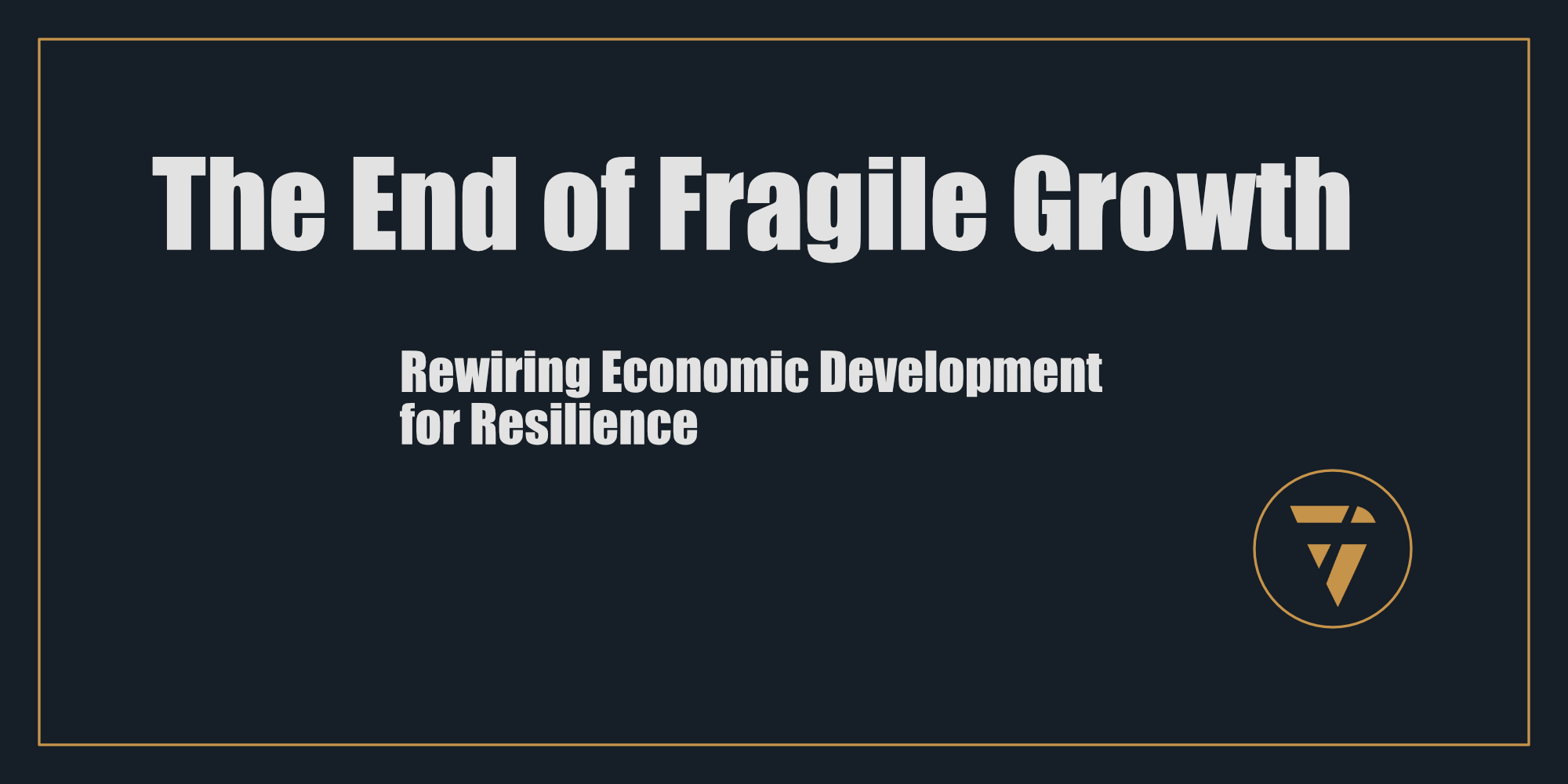The End of Fragile Growth

Rewiring Economic Development for Resilience
For decades, economic development has been built on a simple assumption: growth equals success. The bigger the economy, the stronger it is. The more money moves, the better off everyone becomes.
This model has driven government policy, corporate strategy, and financial markets for generations. It has fueled globalization, industrial expansion, and speculative investment. It has delivered extraordinary wealth to a select few.
But it has also created an economy that is increasingly fragile, unequal, and unsustainable.
Growth, as we define it today, is deeply flawed:
- It depends on constant expansion—even when resources are finite.
- It prioritizes short-term gains over long-term resilience.
- It concentrates wealth and power rather than distributing it.
- It leaves communities vulnerable to shocks—from financial crises to supply chain failures.
The problem isn’t growth itself. The problem is fragile growth—a system designed for speed rather than strength, for scale rather than sustainability.
If the 20th century was about pursuing growth at any cost, the 21st century must be about building resilience first.
The future of economic development is not about how fast we expand. It is about how well we endure.
Why Fragile Growth Fails
Our current economic system is structured around efficiency, optimization, and centralization—all of which make it vulnerable to failure.
We have built an economy that is:
- Over-leveraged—where financial markets drive growth based on speculation rather than real value.
- Over-concentrated—where a handful of corporations and financial institutions control critical industries.
- Over-dependent—where supply chains stretch across the world, leaving businesses vulnerable to disruption.
This has made modern economies highly unstable, with each crisis exposing deeper weaknesses:
- 2008 financial collapse—a global recession driven by speculative, high-risk financial structures.
- COVID-19 supply chain failures—an over-optimized system that could not handle shocks.
- Climate-driven disasters—entire industries crippled by resource shortages, extreme weather, and environmental instability.
These crises are not anomalies. They are symptoms of a fragile economic system.
A system that prioritizes growth without resilience is not built to last.
The Shift: Resilience Over Scale
A resilient economy does not collapse under pressure. It adapts. It absorbs shocks. It continues to function even when faced with disruption.
This requires a fundamental shift in mindset. Instead of asking, “How do we grow bigger?” we need to ask, “How do we build an economy that can withstand crisis, sustain communities, and create lasting prosperity?”
This means:
- Decentralizing economic power—moving away from monopolies and corporate dominance.
- Localizing production and supply chains—building regional resilience instead of relying on fragile global networks.
- Reinvesting in small businesses and community ownership—so that economic value stays where it is created.
- Shifting from speculative finance to real value creation—prioritizing industries that produce tangible, sustainable wealth.
This is not a retreat from progress. It's a redesign—an economic model that prioritizes longevity over volatility.
How to Build a Resilient Economy
A resilient economic system is built on five key principles:
1. Distributed Economic Power
Economic resilience starts with breaking dependence on centralized power structures.
Today, a handful of multinational corporations dominate industries from retail to agriculture to finance. When they fail, entire economies suffer.
Instead, we must build economies that are distributed, diversified, and decentralized:
- Strengthening regional economies rather than relying on global monopolies.
- Supporting co-operative ownership models that reinvest in workers and communities.
- Breaking up monopolistic control over industries through antitrust policies.
The more widely economic power is distributed, the less vulnerable communities become to external shocks.
2. Local and Regional Self-Sufficiency
Fragile economies depend on long, complex supply chains that are efficient in ideal conditions but collapse under stress.
A resilient economy prioritizes local production and regional supply networks, ensuring that businesses and communities can continue operating even when global systems fail.
- Investing in regional manufacturing hubs rather than outsourcing all production overseas.
- Strengthening local food systems to reduce dependence on distant supply chains.
- Developing community-based energy grids that are independent from national infrastructure failures.
The more self-sufficient a local economy is, the less it suffers in a crisis.
3. Investment in Durable Industries
Fragile economies rely on industries that chase short-term returns: speculative finance, real estate bubbles, extractive industries.
Resilient economies invest in industries that produce real, long-term value:
- Sustainable agriculture and regenerative land use.
- Durable manufacturing with local supply chains.
- Renewable energy and decentralized power production.
- Public infrastructure that increases long-term stability.
Wealth built on speculation will always be fragile. Wealth built on tangible, productive industries will endure.
4. Long-Term Thinking in Business and Policy
Economic policy is often designed around quarterly earnings reports and election cycles—short-term incentives that encourage fragile, unsustainable growth.
Resilient economies require long-term strategies, such as:
- Policies that prioritize economic stability over short-term financial gain.
- Business models that focus on generational wealth creation rather than rapid scaling.
- Investment in education and workforce development that ensures long-term adaptability.
Short-term growth is easy. Sustainable prosperity requires long-term planning.
5. Community-Led Development
Top-down economic planning often fails because it does not reflect real, local needs.
A resilient economy is built from the ground up:
- Worker-owned businesses that give employees control over decision-making.
- Public banking and community investment funds that keep capital within local economies.
- Small business networks that support each other instead of competing against monopolies.
The most stable economic structures are those controlled by the people who live and work within them.
The End of Fragile Growth Is the Beginning of Economic Strength
The pursuit of rapid, unsustainable growth has left the global economy vulnerable.
We do not need to scale back progress. We need to redefine it.
- Growth that does not collapse under pressure.
- Growth that creates shared prosperity, not just concentrated wealth.
- Growth that builds resilient communities rather than fragile dependencies.
Economic power should not belong to those who exploit short-term opportunities. It should belong to those who build systems that last.
The end of fragile growth is not a loss—it's a beginning. It's the foundation of a new economic model—one that does not break in times of crisis, but grows stronger because of them.
This is what I’m working on. Tell me what you think, I enjoy the conversation! Subscribe and follow the work in real time.
Thanks!
B

Growth that collapses under pressure isn’t growth, it’s a liability.
Real economic strength isn’t built on scale alone, but on resilience, decentralization, and durability.
The future belongs to those who build to last.
PS -






